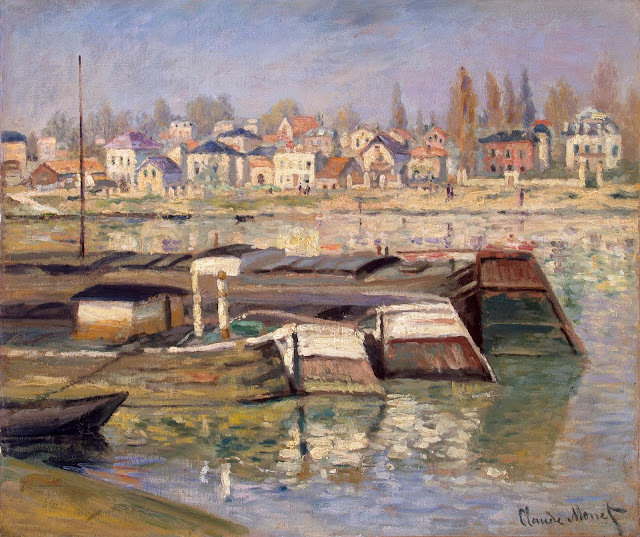 |
| Alfred Sisley Bridge at Villeneuve la Garenne 1872 oil on canvas Metropolitan Museum of Art, New York |
 |
| Alfred Sisley Villeneuve la Garenne 1872 oil on canvas Hermitage, Saint Petersburg |
"How could one deny the existence of collective fashions? But I have to say that often they are negative. What can easily happen is a kind of social taboo. Certain things are not done. After the triumph of Impressionism, no one who wished to be taken seriously would paint purely photographic or anecdotal pictures. I call this in one of my papers 'the principle of exclusion'. If you accept this exclusion there are many things you can still do, provided you do not do what is now socially taboo, which is considered passé and vieux jeu. You are then confronted with a new array of possibilities and only those who are really original and inventive can, within these new limitations, create something which becomes accepted, and a fashion. So, the negative is very important in the history of art."
 |
| Claude Monet Seine at Rouen 1872 oil on canvas Hermitage, Saint Petersburg |
 |
| Claude Monet Seine at Asnières 1873 oil on canvas Hermitage, Saint Petersburg |
"It means that, again, certain possibilities are denied to the artist. Because they have been done before, they are taboo now. And one element in the situation is that he wants to be a success. He wants to make an impression. He is groping his way (not of course consciously) towards something which will be accepted. I sometimes compare it to the growth of a tree. A tree in a wood will always move towards the light. And an artist also develops towards the light, towards people who favor him. He will notice that, unexpectedly perhaps, this or that innovation really makes an impression and he will go on in that direction. I do not want to give the impression that artists are all opportunists. But up to a point everybody wants to please. I touch on this problem in the introduction to The Story of Art, where I quote a letter by Mozart from Paris, where he says: every symphony here starts with a fast movement so I start with a slow introduction. That is part of the logic of the situation: being different and yet acceptable. There is also a limit beyond which it ceases to pay off: if you do something entirely different, it is unintelligible."
– from Looking for Answers: Conversations on Art and Science, by Ernst Gombrich with Didier Eribon (Abrams, 1993)
 |
| Claude Monet Corner of the garden at Montgeron ca. 1876 oil on canvas Hermitage, Saint Petersburg |
 |
| Claude Monet Pond at Montgeron ca. 1876 oil on canvas Hermitage, Saint Petersburg |
 |
| Jean-Léon Gérôme Pool in a Harem ca. 1876 canvas Hermitage, Saint Petersburg |
 |
| Alfred Stevens After the Ball 1874 oil on canvas Metropolitan Museum of Art, New York |
 |
| Claude Monet Garden 1876 oil on canvas Hermitage, Saint Petersburg |
 |
| Jean-Louis-Ernest Meissonier Musketeer 1870 oil on panel Hermitage, Saint Petersburg |
 |
| Paul Cézanne Apples, Peaches, Pears, Grapes ca. 1879-80 oil on canvas Hermitage, Saint Petersburg |
 |
| Paul Cézanne Fruit ca. 1879 oil on canvas Hermitage, Saint Petersburg |
 |
| Paul Cézanne Jas de Boufon - The Pool ca. 1876 oil on canvas Hermitage, Saint Petersburg |
 |
| John Singer Sargent A Road in the South ca. 1878 oil on canvas Clark Art Institute, Williamstown, Massachusetts |